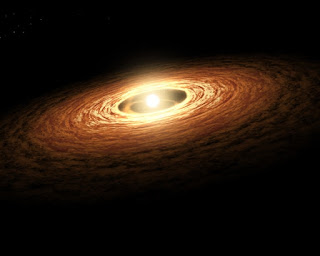NASA's Dragonfly Mission: Unveiling The Secrets Of Saturn's Moon, Titan
NASA's dragon fly mission aim is to search for prebiotic chemical processes and habitability in saturn's moon Titan.In this mission a rotorcraft fly on Titan and collect important data.This will be the 1st mission have rotorcraft fly on other than earth and mars surface and also rotorcraft fly on other earth moon.This will become 1st mission have rotorcraft fly on TiTan.
 |
| Dragonfly spacecraft,rotorcraft fly over the surface of saturn's moon (Titan).credit: Nasa |
Mission objective
This mission (dragonfly) is designed to study the surface composition,atmosphere condition and geologic processes in Titan.The rotorcraft will fly to different location on moon,collect samples and conduct experiments at same time.The mission primary objective includes :
• Assessing the microbial habitability on Titan
•Studing the prebiotic chemistry of Titan at different places
• Perform fly to different locations etc..
Space craft design and instruments it contains
The space craft is designed as a rotorcraft lander, it is similar to Quadcopter having two rotors. It contains eight rotors,which will help in case of malfunction.This space craft powered by a lithium-ion battery which powered by a Multi Mission Radioisotope Thermoelectric Generator (MMRTG) during night times
The dragonfly spacecraft equipped science instruments:
• Dragonfly Mass Spectrometry (DragMS),identifies the chemical composition in surface and atmosphere samples
• Dragonfly Gyama Gays and Neuton Spectrometer (DragGNS),identifies the surface composition under lander
• Dragonfly Geophysics and Meteorology Package (DragGMet),a set of meteorology sensors which includes seismometer
•Dragonfly Camera set(DragCam) it consists of microscopic and panoramic cameras.
 |
| NASA's dragonfly spacecraft,rotorcraft on saturn's moon surface (Titan).credit:Nasa |
Launch and Trajectory
The Dragonfly mission is scheduled to launch in July 2028.This mission costs about $3.35 billion. The spacecraft will perform a gravity assist flyby of Earth to gain additional velocity to get into the way to Titan.The Space craft will reach titan in 2034
Entry and Descent
The cruise stage will separate from the entry capsule ten minutes before entering into the Titan's atmosphere. The lander will descend to the surface using an aeroshell and with the help of two parachutes, while the spent cruise stage will burn up in uncontrolled atmospheric entry. The duration of the descent phase is expected to be 105 minutes
Landing Site
The Dragonfly rotorcraft will initially land in, dunes to the southeast of the Selk impact structure at the edge of the dark region, Shangri-La. It will explore this region in a series of flights up to 8 kilometers each, collecting samples from compelling areas with diverse geography.
NASA's dragonfly mission will help us to learn about saturn's moon(Titan) by studing atmosphere and surface.This may be leading to understand more about our solar system and also helpfull for our future missions.
FAQs :
What is the Dragonfly mission?
The Dragonfly mission is a NASA mission to explore Saturn's moon, Titan, using a rotorcraft lander.
What are the objectives of the Dragonfly mission?
The mission aims to study the surface composition, atmospheric conditions, and geologic processes of Titan, as well as search for prebiotic chemical processes and habitability.
When will the Dragonfly mission launch?
The mission is scheduled to launch in July 2028.
How long will the mission take?
The spacecraft will arrive at Titan in 2034, after a journey of approximately six years.
What instruments will the Dragonfly spacecraft carry?
The spacecraft will be equipped with a suite of scientific instruments, including a mass spectrometer, gamma-ray and neutron spectrometer, geophysics and meteorology package, and camera suite.




Comments
Post a Comment